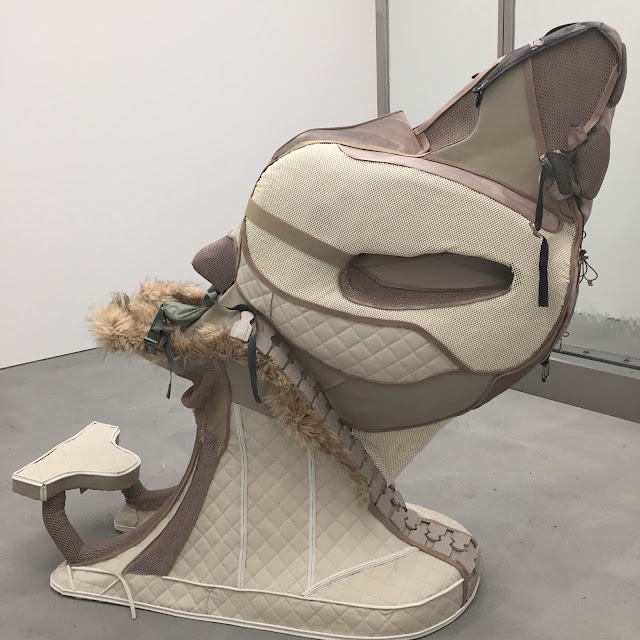Anna Uddenberg, Sante Par Aqua, Installation view, Kraupa-Tuskany Zeidler, Berlin, 2017.
04.11.2017–13.01.2018
At first glance, Anna Uddenberg's sculptures at the Sante Par Aqua (SPA) exhibition, at the
Kraupa-Tuskany Zeidler gallery in Berlin, look like a fleet of swarmed spaceships ready to take off. But
they are also difficult seats. The Swedish artist presented a series of new works that recall a dystopian
world that is a mix of the TV series Black Mirror and Westworld.
In the first room there are three sculptures the size of three large armchairs. In the second room, two
glass walls, in which an artificial waterfall flows, form a cage inside which there is a large sculpture like
an alien presence, almost totemic.
The scalar and asymmetrical shapes insist on the dynamism of the object while the fabric in which they
are made returns sensuality to the coldness of the machine. In fact, the detachment from reality, the alienation,
is increased by the fact that the sculptures rise on a luminous base that seems to lift the sculpture in flight.
Anna Uddenberg, Sante Par Aqua, Installation view, Kraupa-Tuskany Zeidler, Berlin
The works are made with a combination of different materials: expanded polystyrene, acrylic resin,
fiberglass, polyurethane foam, HDF, automotive interior elements, synthetic leather, synthetic fur, vinyl
floor, hiking backpacks, foam strips of vinyl, along with different supports such as the hairdresser's chair.
Anna Uddenberg, who became famous thanks to her anthropomorphic sculptures, half human body
(* female) and half object (* commodity), like suitcases and buggies, extends her research in a direction
that concerns architecture and space as a social body .
The SPA is a neutral place, dedicated to the care of the body, but also a social space. A cradle of
well-being where the body has become itself a goods, an object of luxury, far from real welfare and the
right to health.
The ostentation of luxury becomes the negation of the reality of the body, its heaviness and its true needs.
Moving further her research from her previous body of works, Anna Uddenberg crates machines, that
have lost the human part, not because they have introjected it, but because they are completely missing.
On the contrary, it almost seems that they ask the visitor to be completed, to be assembled. These
machines are virtually move in a dimension that sees the imagination as a viable sea.
On the contrary, in line with the previous works, Anna Uddenberg's sculptures relate to the surface, not as
a general concept, but as a specific subject: the sculptural surfaces so captivating at first glance, actually
hide a patient hand-stitching work. A bit like our 'surreal' concept of well-being hides a series of
unrealistic real needs that are completely trapped in the unneeded.
Anna Uddenberg, "Pockets Obese", mixed media, Courtesy Kraupa-Tuskany Zeidler, Berlin, 2017.



